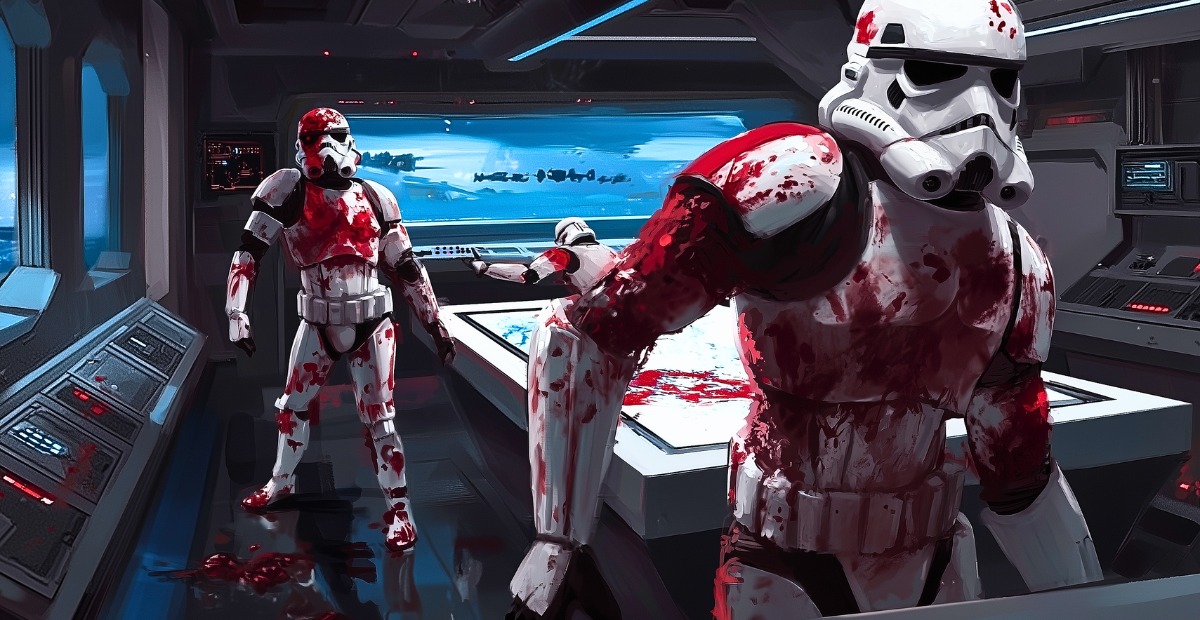Blackwing—also called “the Sickness”—started as a Sith attempt to beat death and later became an Imperial black project. In Legends continuity, its roots run through Old Republic–era Sith alchemy and end up on an Imperial Star Destroyer where a weaponized strain turns crews into coordinated undead.
In Canon, the virus surfaces through the mobile game Star Wars: Commander, where Imperial experiments on Dandoran create “Undead Troopers” and trigger containment missions for both Empire and Rebels. The name “Project Blackwing” and “the Sickness” appear directly in Canon materials tied to that game and its official coverage.
An Immortality Formula With A Fatal Flaw (Legends)
The first phase belongs to the Sith. Long before the Empire, Darth Drear designed an immortality elixir that relied on Sith alchemy and a rare Murakami black orchid, a Force-sensitive plant. The elixir kept bodies from following the normal course of death, but it carried one defect: the mixture became an infectious agent that attacked living tissue and reanimated the dead.
Drear’s work failed, claimed his life, and left behind instructions that others could follow. Centuries later, Darth Scabrous tried to complete what Drear could not. His experiments, which again used the orchid as a catalytic ingredient, triggered an outbreak at a Sith academy on Odacer-Faustin.
These events form the backbone of Red Harvest, which serves as the virus’s origin story in Legends.
Project I71a Blackwing And Its Weaponization (Legends)
During the Imperial era—about a year before the Battle of Yavin—Darth Vader directed the Imperial Biological Weapons Division to recover and re-engineer the Sickness as Project I71A, codenamed Blackwing. Research teams aboard the Imperial Star Destroyer Vector refined a fluid strain and an airborne strain with the goal of halting decay and animating muscle and nerve receptors after clinical death.
A cargo mishap led to leaks, the airborne agent moved through the ship, and the Vector turned into a closed-ship outbreak. Those events tie directly into Death Troopers. The Legends entry for Project I71A documents the Vader directive, the Vector incident, and the program’s aim to create a deployable bioweapon.
What Blackwing Does To A Host
Transmission. Blackwing spreads by bites, contact with infected fluids, and—when released from containment—airborne exposure. Incubation times vary by route: seconds to minutes for bite victims; hours for fluid or airborne cases. The airborne version cuts through standard protective gear, which explains why closed facilities and ships fare poorly once a leak starts.
Clinical course and reanimation. Victims show respiratory distress, fever, gastrointestinal problems, neurological symptoms (hallucinations, violent behavior), and rapid tissue necrosis, followed by death and reanimation. After reanimation, bodies keep moving because the agent stimulates muscle and nerve receptors.
Collective intelligence and learning. Reanimated groups share information and adapt, which lets them learn to use blasters, operate turrets, manipulate tractor beams, and even attempt to pilot vessels. That escalation is one reason Imperial ships became traps once the virus broke containment.
Contagious medium. Narratives repeatedly mention a gray coagulated fluid that carries the agent through bodies and across surfaces. In a few documented cases, very early removal of infected tissue or amputation slows or stops local spread, but clinicians in-story emphasize that these measures are last-ditch and time-critical. Once systemic signs appear, results are poor.
Constraints And Countermeasures
Airborne-strain dependence. When Blackwing rides a contaminated atmosphere, distance from the source matters. Legends accounts show undead crews losing function when they move ships away from an area saturated with the agent; several escape attempts fail because the pilots degrade once that environmental support drops. That limit does not make the virus safe; it only explains why some flights end before the infection jumps systems.
Anti-virus and natural immunity. A small number of humans carry a genetic resistance to the airborne strain. Medical teams synthesize an anti-virus from that profile to protect uninfected personnel. It buys time for evacuations and limited operations, and it appears later in the Dathomir incident, but it does not reverse full reanimation.
Tactics that work. Containment relies on aggressive destruction of reanimated tissue (incineration, heavy ordnance, severing critical structures) and environmental control (sealing, venting, denying access to transport). When those steps slip—even briefly—group learning flips the advantage to the undead.
Canon Snapshot: What Made It Into Modern Continuity
In Canon, Project Blackwing appears through Star Wars: Commander and its official coverage on StarWars.com. The missions set on Dandoran describe an Imperial research facility, Undead Troopers, and dual-faction operations to contain outbreaks and retrieve data. Canon copy also notes that the Imperial Military Department of Advanced Weapons Research and Sith scientists were tied to the project’s goal of unlocking immortality, language that mirrors the Legends arc without importing all its details. Additionally, official materials connect the “Death Troopers” name for Imperial soldiers to this project’s notoriety, but those elite soldiers are not portrayed as zombies in Canon storytelling.

